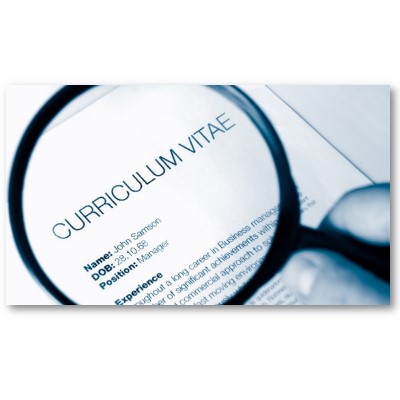Email Applications: How Nigerian Graduates Goof (I)

By
Learning they say is a continuum of experiences. I recently had course to support a start-up organisation in assessing email applications and conducting interviews for shortlisted applicants. It offered me a deeper insight into the dynamics of job search and screening process. Few curriculum vitae, CV were carefully and brilliantly crafted while more than 70% of the applications fell short of basic expectation; not in terms of the qualification of applicants but in terms of the shoddy email content and document formats. I had my first curriculum vitae when I was 16. I had just left secondary school about a year earlier and wanted to get busy while awaiting admission into a tertiary institution as young people my age then were in the habit of doing. I had seen a number of curriculum vitae at home; they were my father’s possession, dropped then by graduates seeking his help with job placements. I took two of them and based on my lean experience and exposure, I came up with an honest document barely more than a page and half and paid a business centre attendant to have it typed. The two different jobs I sought, I got them majorly on the merit of the resume. I recall that the executive director of a non-profit who was the final interviewer was impressed that I had such a document to my name at that age. Last time, I dug up the document from my archive; I smiled in the knowledge of the naivety and juvenile bravery of that period.
Of the almost 40 applications we had to review, I recall seeing a CV that looked almost like what I had several years back. There was nothing thick to take away from it to fully access the applicant with. It was merely about the institutions the applicant had attended but with changed times, we now know the hood does not make a monk. Before the interview, the CV and often times the cover letter are the only documents with which the employer measures and sort of tests the quality and ability of the candidate. It is the first assessment and a lot depends on it. If anything, applicants owe themselves the responsibility of ensuring that the document(s) snatches the attention of the employer especially among the sea of several others. Given that the call for applications in question ran for just five days, which was partly during the yuletide, it was understandable that thousands of applications were not received as in now the norm. The application call and request was clear. The job description was spelt out; the documents needed were clearly stated and in the manner in which they should be attached. A few more instructions followed and applicants were asked to stick with the instructions. Surprisingly, only about 20% of applicants adhered to the instructions as stated. This piece is one I chose to write based on this limited experience hoping it would set some applicants who can afford to read through the length on the right path and possibly have them get it right and better their prospects.
Since most applications are now requested through the new media channel, it means the success of an application or not starts from this phase. Usually, it starts with the email address and the delivered name of the sender. Courtesy and expediency makes it wrong to use email addresses that comes across as playful. Some of the examples we got were in the mould of the following – okonjo4real@yahoo.com, guyamaechi@hotmail.com, ribadu4luv@yahoo.com handsomesheggzy@gmail.com oduah2000x@onebox.com These are possibly the type that were opened when email was just becoming popular in Nigeria and we paid cybercafé attendant to open an email for us. It is always better if email addresses bear the full names or an abbreviation of one of the names of the applicants. aminuturaki@yahoo.com, aturaki@gmail.com, aminu_turaki@hotmail.com or aminu.turaki@gmail.com comes across as better. It costs nothing to have such carefully decided upon and officially toned email address. Also key is the name that drops in the box of the employer. It should be the name of the employee (with the first letter of each name being in capital letter) and not the email address as was the case with this experience or a name that is an alias. Any applicant with such can adjust this through the setting option of the email service provider. It is best to think like the employer. We decided to give all the applicants a chance in this case and coincidentally, we discovered that the seven candidates that were shortlisted for interview did not have funny email addresses and followed through all the instructions. The interpretation on empirical basis is that employers can justifiably ignore applicants who do not follow through instructions and meet basic but unwritten expectations.
In a particular instance, an applicant sent his own mail application with a friend’s mail address; so the CV carried a name different from the sender. Another simply forwarded the CV and cover letter that had been earlier sent to another organisation. The name of the organisation was visible and the cover letter was seeking for a job different from what this particular employer was calling for. In drafting a cover letter, it is also important that it is properly edited and the addresses placed appropriately in tandem with basic letter writing skill. The thinking of an average employer is that is an applicant is not meticulous enough with a task as simple as sending an application; he or she is not likely to be on the job.
I also saw different names applicants used in saving the documents they attached to the mail. Some carried names like – multipurpose CV, skjnewcv, dorcas+cv, bankcv. It should not be the case. Documents should be properly labelled to suit the purpose. And since there would be several people sending CVs to the same email address. It is good such document carries the name of the applicant to make it easy to sort out. (Inspection Officer Application from Rotimi Wakoli) is an example of how it should be done expect instruction states otherwise.
There should also be a content or body of email. I suppose it is wrong to simple attach the necessary document(s) and send a blank mail. The space is a good way to quickly sell oneself by writing a summary of the purpose of the mail and end with a signature that carries your name and other new media contact which may include ones twitter handle, LinkedIn account, Facebook link especially if they are rich enough and the applicant is sure of the content present in these places. They may serve to enhance the quality of the application.
Where possible, a research about the organisation or the industry calling for the application may also serve the applicant’s interest. I recall an opening I rued missing simply because I was not patient enough to research. My guess is that I did not get a response simply because I had sent a ‘Dear Sir’ instead of a ‘Dear Ma’. When later I tried to find out what went wrong, it turned out that the CEO whom I sent my document to is a feminist and I was blind not to have seen that on the site. Writing a ‘Dear Sir’ was interpreted to be male chauvinism.
The second part of this article features tomorrow; let us continue the conversation via @SolaFagro on twitter.
Email Applications: How Nigerian Graduates Goof (II)
Email Applications: How Nigerian Graduates Goof (III)
Established in March 2013, JarusHub is a Nigerian information hub with focus on career and management. It is rated Nigeria's most authoritative destination for online career resources. It parades an array of Nigerian professionals who share their career experiences with a view to bridging career information gap and mentoring a generation to success. Whether you're a student, a recent graduate or an established professional, or even an executive, you will always find something to learn on JarusHub. All enquiries to jarushub@gmail.com or 0808 540 4500. Facebook: www.facebook.com/jarushub; Twitter: @jarushub or @mcjarus.
Path to Big 4: Stream 11
April 4, 20245 Best Useful Applications Of AI in Modern World
November 17, 2023Career Q&A with Jarus: Oil & gas career, poor CGPA
September 17, 2023
13 comments
Let us have your say by leaving a comment belowCancel reply
Recommended For You
-
A Tale of an Investment Banker and a Blogger
September 18, 2020 -
How do I become a “great guy” in Finance?
December 25, 2013 -
QUESTIONS & ANSWERS WITH FEMI AWOYEMI, CEO, PROSHARE NIGERIA
October 2, 2014









Is possible you help someone with the know- how of writing good CV
This is an absolutely fantastic and helpful piece by Sola Fagro and I hope young Nigerians will learn after reading this. You cannot imagine the speed with which such e-mails are thrashed especially when the employer was very clear with what he/she wants.
Sola, you just took these words right out of my mouth. I have recently launched a campaign on my networks about these same issues. Only a recruiter can share your frustrations. People keep complaining about not getting jobs but they don’t even realise that they are not employable. I have a portfolio of BAD resumes. Sometimes I laugh so hard, sometimes I just feel so sad and almost weep at the quality of graduates being churned out from our universities. You send out about 5 job adverts, receive about 2000 resumes by e-mail and only 12 of these are actually titled! Cover letters are so poorly worded (even though I’m not a fan of those), Resumes are full of irrelevant details such as “Married to Oluwakemi & blessed with Mayokun & Feyisayo”. For real? Who cares? My God! I could go on and on. Thanks for this Sola. I’m glad I have a forum to share my rants.
Mr. Sagro, “majorly” is not a word.
Mr. Thinas, “majorly” is a word. The problem is d usage here, it’s a slang and as such it ought not be used in a formal writing like this. Extremely would have been appropriate.
Beautiful article. Awaiting the next post.
This is a lovely piece sir. One of the many problems we have with youths of nowadays is that they are not patient enough to pay attention to details, and also to make corrections when necessary. I was guilty of some of the mistakes above, but learnt my lessons after reading several articles on job applications.
Tanx Jarus,(1) in part 2,u said its preferable if attached docs. Are not in pdf format but I read in some oda blogs by recruiters as well who opined dat such documents shd be in pdf? (2)if its D applicant’s name dt drops in d employer’s box, would dey be able to send a reply to d mailbox since its only d name dat appears in their inbox?
1, This article was written by one of my columnists, Sola Fagorusi after spearheading the recruitment process for an outfit. He must have had issues with PDF applications. I share same opinion: CVs are better sent in Ms Word except where recruiter specifies it must be in PDF. 2, It is not possible to send email and the email address of sender will not appear in the inbox of teh receiver.
[…] Email Applications: How Nigerian Graduates Goof (I) […]
[…] Expectedly, my last article on the above subject generated considerable interests. I got numerous inquiries via mail and twitter on some of the issues raised in the expose. The contemporary unemployment situation in Nigeria makes the competition for the few available job spaces keen. […]
[…] and Social Media evangelist, Sola Fagorusi, recently did a widely traveled 3-part series on the mistakes Nigerian graduates make in email applications. The articles, inspired by his experience assisting a startup NGO recruit, were well […]
j